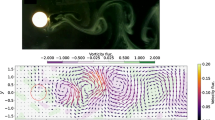Abstract
Acoustic sounding of the wake behind a circular cylinder and observation of the shadow pattern indicate that for a density gradient varying on distances of the order of the cylinder's vertical dimension two parametrically different vortex systems may coexist in the wake. In the particular case when the profile of the buoyancy frequency is symmetric and its axis coincides with the path along which the cylinder's axis travels, the vortex systems on both sides of the wake are nearly identical. However, if the axes do not coincide, then the structures of the upper and the lower parts of the wake are rather different.
If the Froude number Fr=u/NR is based on the flow velocityu, the radius of the cylinderR, and the current value of the buoyancy frequencyN, then the observed flow pattern corresponds to known regime diagrams presented by several authors. In the present experimentsN was found using the characteristic periods of oscillation of the intensity of volume ultrasonic scattering.
The vertical profiles of the coefficient of backscattering of ultrasound and the synchronous shadow flow patterns in the wake behind the body are subjected to simultaneous analysis.
Similar content being viewed by others
References
I. V. Voeikov and Yu. D. Chashechkin, “Formation of discontinuities in a stratified flow past a cylinder,”Izv. Ross. Akad. Nauk, Mekh. Zhidk. Gaza, No. 1, 20 (1993).
D. Boyer, P. A. Davies, H. Fernando, and X. Zhang, “Linearly stratified flow past a horizontal circular cylinder,” Phil. Trans. Roy. Soc. Ser. A,328, No. 1601, 501 (1989).
Yu. D. Chashechkin and I. V. Voeikov, “Vortex systems downstream of a cylinder in a continuous stratified fluid,”Izv. Ross. Akad. Nauk, Fiz. Atmos. Okeana,29, No. 6, 821 (1993).
S. V. Makarov and Yu. D. Chashechkin, “Attached internal waves in a fluid with an exponential density distribution,” PMTF, No. 6, 47 (1981).
L. A. Chernov,Waves in Randomly Nonuniform Media [in Russian], Nauka, Moscow (1975).
A. Brandt, “Acoustic return from density fluctuations in turbulent jets,” in: Proc. 11th IEEE Conf. Eng. Ocean Environ. and Mar. Technol., San Diego, Calif., IEEE, New York, 8 (1975).
V. E. Prokhorov, “Remote measurement of the parameters of dynamic nonuniformities in a stratified fluid,”Izv. AN SSSR, Fiz. Atmos. Okeana,25, No. 1, 90 (1989).
V. E. Prokhorov, Yu. D. Chashechkin, and I. V. Voeikov, “Optical and acoustic observation of the flow downstream of a cylinder in a stratified medium,” PMTF,34, No. 3, 68 (1993).
V. E. Prokhorov and Yu. D. Chashechkin, “Ultrasonic sounding in a model hydrophysical experiment,” Preprint No. 514 [in Russian], Institute of Problems of Mechanics of the Russian AS, Moscow (1992).
L. Goodman, “Acoustic scattering from ocean microstructure,” J. Geophys. Res.,95, No. C7, 1557 (1990).
Additional information
Moscow. Translated from Izvestiya Rossiiskoi Akademii Nauk, Mekhanika Zhidkosti i Gaza, No. 6, pp. 3–12, November–December, 1995.
Rights and permissions
About this article
Cite this article
Prokhorov, V.E., Chashechkin, Y.D. Structure of the wake behind a cylinder in a fluid with a variable buoyancy frequency, studied with the help of echo sounding and optical observation. Fluid Dyn 30, 803–809 (1995). https://doi.org/10.1007/BF02078192
Received:
Issue Date:
DOI: https://doi.org/10.1007/BF02078192




